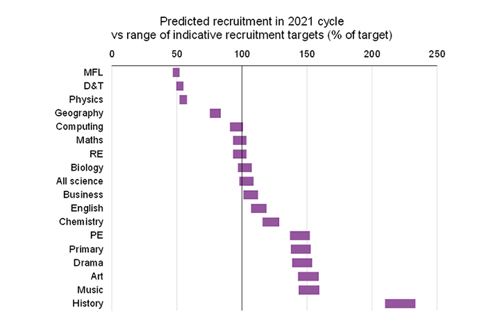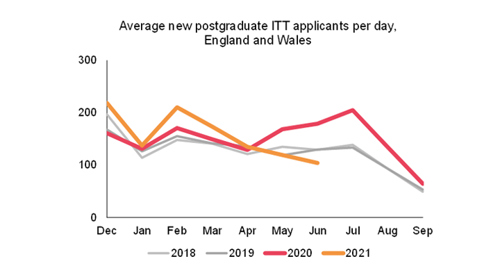Which subjects may need a bursary boost next year to attract enough new teachers?
Friday 2 July 2021
 The fourth in a series of blogs on Covid-19 and the teacher workforce sees NFER School Workforce Lead Jack Worth look at whether the Covid surge in teacher training applications is coming to an end.
The fourth in a series of blogs on Covid-19 and the teacher workforce sees NFER School Workforce Lead Jack Worth look at whether the Covid surge in teacher training applications is coming to an end.
The recession induced by Covid-19 led to an increase in applications to postgraduate initial teacher training (ITT), as people sought refuge in the relative safe haven of teaching while the wider labour market is weak.
The application surge started in summer 2020, leading to primary and secondary end-of-year ITT targets being met for the first time in seven years. The boost to applications continued in the early part of the 2021 cycle, meaning that applications in England up to mid-June 2021 are 19 per cent higher than they were at the same point in 2019.
However, yesterday's UCAS data on teacher training applications suggest the rate of applications is slowing down and that the Covid surge may even be over. Ahead of the three-year spending review, the Department for Education (DfE) needs to be planning for teacher recruitment and retention policymaking in a post-Covid world.
Recruitment is likely to be healthy across most subjects in 2021. The good news in yesterday’s data is that due to that boost to applications early in 2021, ITT entries are looking very healthy. Indeed, the DfE’s bursary changes, which were almost all reductions in subjects that would otherwise have over-recruited, mean that the profile of applications is well balanced across subjects.
It is difficult to say for sure whether teacher recruitment this year will be sufficient to meet supply needs, as DfE has not published targets this year. However, our best estimate suggests that supply needs are likely to be met across almost all subjects.
The chart below shows a prediction of recruitment compared to supply need for each subject. We first forecast how many trainees are likely to take up postgraduate ITT places in 2021, by multiplying the end-of-year number of trainees in 2019 by the extent to which applications in that subject in mid-June 2021 are ahead of applications in mid-June 2019.
We then compare the expected number of trainees to the target for the number of teachers required that was set for each subject in 2020. New targets for 2021 have not yet been published, so this is only an indicative comparison. Many factors may have evolved and changed the targets, such as pupil number forecasts, policy changes (e.g. the teacher supply requirements of Covid Recovery) and retention rates.
Indeed, we know from DfE data that the number of teachers leaving was 17 per cent lower in 2020, so it is reasonable to assume the 2020 targets, all else equal, may slightly overstate supply needs. To reflect this, the chart shows an estimated range, also reflecting the scenario in which the targets are 10 per cent lower due to higher retention across all subjects.

Source: NFER analysis of UCAS ITT applications data and DfE ITT Census data.
The estimates show that recruitment for most subjects is likely to be at or above the indicative target in 2021. It is pleasing to see this includes perennial shortage subjects such as maths, chemistry, computing and science overall. Retaining high bursaries for these subjects has enabled the application boost to help meet targets that have been missed for many years.
However, a handful of subjects stand out as being unlikely to reach the target in spite of the application surge. Applications to physics are 26 per cent higher in 2021 compared to 2019, but it remains unlikely to reach its target. This is likely to be due to the relatively small pool of physics graduates, which makes recruitment challenging whatever the context.
Applications to modern foreign languages (MFL) are 18 per cent lower in 2021 compared to 2019. This is largely due to the bursary being cut from £26,000 to £10,000, which suggests that MFL recruitment has been intentionally de-prioritised. The 2020 target for MFL was very high due to the ambition of at least 75 per cent of pupils studying MFL by 2022 and 90 per cent by 2025. There has been no policy changes about EBacc announced, but as we speculated in March, such a deliberate move to reduce the MFL bursary suggests that meeting the EBacc target has been de-prioritised.
The geography target had been falling for several years up to 2020, due to the changing requirements of EBacc. Therefore, geography recruitment compared to need may be healthier than it appears, despite cuts to its bursary from £26,000 to £15,000 in 2020 and to zero in 2021. Design and Technology (D&T) – its bursary was cut from £15,000 to zero – may have been de-prioritised as it is a non-EBacc subject, but we expect it to be significantly below target.
There are early signs that recruitment challenges may be about to re-emerge in 2022
However, yesterday’s ITT data is not entirely good news for on-going teacher supply. There are signs over the last few months that the rate of applications to ITT has slowed considerably. The numbers of new applications per day in May and June have been at the same level as in 2018 and 2019, and below the 2020 level. This coincides with the steady recovery in the wider labour market, due to the gradual lifting of Covid-19 restrictions.

Source: NFER analysis of UCAS ITT applications data.
This, in turn, may mean that the rate of applications to teacher training has permanently slowed to pre-pandemic levels. While recruitment in 2021 is looking healthy due to the early boost, an entire cycle with an application rate at 2019 levels in 2022 is likely to lead to recruitment being below what is required for a number of subjects.
The Government will need to make changes to ensure sufficient supply in future years
Bursary levels will therefore need tweaking in the autumn, to ensure there is sufficient supply across all subjects. Recruitment for subjects such as English, biology and religious education (RE) risks falling below target if bursaries are not nudged upwards ahead of the next cycle.
Despite £24,000 bursaries for these subjects in 2021, maths, chemistry, computing and physics are likely to be below target in 2022 without additional action on financial incentives. As well as bursary changes, the DfE should consider reintroducing early career retention payments for these subjects, to secure healthy supply into the future.
These changes will require additional fiscal resources, and if the labour market continues to recover into 2023 (which is expected), then more may be needed in future years too. The Government’s autumn spending review will need to carefully consider what resources will be needed to fully support teacher recruitment and retention over the next three years.
